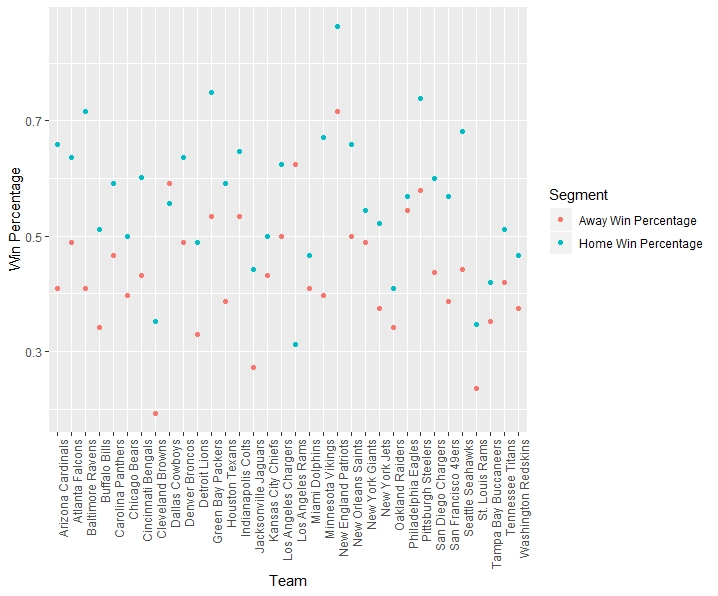Imagine you are in “Death Valley”. It’s a concrete jungle, with Clemson Tigers and orange plastered season ticket holders ready to defend their beloved rock. Now imagine you are a NC State fan, the only one in a sea of South Carolinian hopefuls – your only comrade is a Georgia Tech graduate, who has decided to become part of the “pack” for this one day against #3 Clemson since your tipsy wife offered up her ticket half-haphazardly at a wedding the weekend before…
Like many of my posts, my analysis stems from a question. This time, my Georgia Tech friend got me thinking. He turned to me in the middle of the 3rd quarter, as NC State was down 31 to 0, and exclaimed, “Man it’s loud in here! Do you think there is really such a thing as home-field advantage?”
If there is, I haven’t seen it at NC State… but this did get my brain churning…
Methodology
I decided to analyze data on the NFL, because it is more readily available, stadium sizes are more equivalent in size than college stadiums, and there is more accurate data on weekly attendance numbers. I consulted one of my favorite sites for such data, Pro Football Reference. I pulled weekly performance data, by season for every team, from 2007 to 2017. I was able to obtain the ending score, stadium attendance, and yard and turnover spread for the winning and losing teams – which I coerced into home vs away data.
While I understand that many may debate the value of defensive play as it is benefited by home-field advantage, weekly data was not easily accessible. Since I looked at aggregates of team performance when they played at home and away, as well as their overall performance, I believe that my methodology was a good ol’ duck tape fix over this concern and I felt comfortable moving forward.
The Gridiron
Home teams won 58% of the time from 2007 to 2017.
While not conclusive, discovering this point added some validity to my hunch. Here are how the rest of the variables, points, yards, and turnovers, played out…

This graph looks at the differences between home team performance and away team performance at a macro level – as averages across the NFL. On average, home teams tended to score 12% more points, produce 4% more yards, and commit 5% less turnovers than away teams. While this is a valuable discovery, I soon found that analyzing the NFL as a whole may not be the best approach. So, I started focusing on team performance.
Teamwork Makes the Dream Work
We often hear about the 12th man on a team – the audience and fans that roar throughout the stadium. Here I take a look at the differences between home and away past performance on a key metric – win-percentage.
 As it can be seen, the win percentage of games played at home tends to be higher than the win percentage of games played as a visiting team. Out of all of the teams over this 11 year period, there are only two teams where this does not hold: the Dallas Cowboys and Los Angeles Rams. The LA Rams have a much smaller sample size, due to their move in 2016, causing unsurprising variability from the norm. But, for Dallas, how can you claim to be America’s team when you aren’t even Texas’ team?…
As it can be seen, the win percentage of games played at home tends to be higher than the win percentage of games played as a visiting team. Out of all of the teams over this 11 year period, there are only two teams where this does not hold: the Dallas Cowboys and Los Angeles Rams. The LA Rams have a much smaller sample size, due to their move in 2016, causing unsurprising variability from the norm. But, for Dallas, how can you claim to be America’s team when you aren’t even Texas’ team?…
The 3 teams that saw the largest percentage increase in win percentage when playing at home vs away were the Cleveland Browns (82%), Baltimore Ravens (75%), and the Minnesota Vikings (69%). While being bad over a long period of time will effect these numbers, causing home wins to be even more valuable, you have to chalk this up as a small victory if you are a Browns fan. Maybe there is a trophy out there for being “less bad” at home. Even if this is the case, I want to look at a home-field advantage’s effect on our other performance metrics. Below are treemaps of teams and their data. The size and color of the regions indicate the magnitude in the difference between their home and away performance relative to the other teams on that metric. It must be noted that these graphs only reflect teams that did better at home.

88% of teams scored more points when the home team, compared to when they were a visiting team, on average. The teams that tended to score more at away games were the: Tampa Bay Buccaneers, Indianapolis Colts, Carolina Panthers, and Los Angeles Rams.

85% of teams gained more yards when the home team, compared to when they were a visiting team, on average. The teams that tended to have better production at away games were the: Tampa Bay Buccaneers, Indianapolis Colts, Cleveland Browns, and Philadelphia Eagles.

74% of teams committed less turnovers when the home team, compared to when they were a visiting team, on average. The teams that tended to have less turnovers at away games were the: Oakland Raiders, New York Jets, Dallas Cowboys, Tennessee Titans, San Francisco 49ers, Philadelphia Eagles, Kansas City Chiefs, Carolina Panthers, and Los Angeles Rams.
Now, you may be wondering, “Camden, across these 3 metrics, who tended to perform better at home games than away games? I want to have bragging rights as the best fan-base and the true 12th man, even though I know this analysis isn’t causal.” Well let me tell you, based on the mean percentage difference in performance across points scored, yards gained, and turnovers produced.
Top 5 (Home Performance vs Away Performance):
1. Los Angeles Chargers
2. Arizona Cardinals
3. Pittsburgh Steelers
4. Baltimore Ravens
5. Green Bay Packers
Bottom 5 (Home Performance vs Away Performance):
28. Washington Redskins
29. Philadelphia Eagles
30. Kansas City Chiefs
31. Carolina Panthers
32. Los Angeles Rams
The teams playing in Los Angeles only include their data since the move. The Chargers moved in 2017 and the Rams moved in 2016, meaning they have a limited sample size compared to the other teams. What is interesting is that if the Chargers were still in San Diego, they would be ranked 25th on our scale of home performance vs away performance. The Rams would be 5th if still in St. Louis. Have they flipped positions for the foreseeable future? Or is it a case of the Law of Small Numbers? I’ll let you be the judge of that.
Data Squib Kick
After all of this discovery, I desperately hoped there would be a correlation between differences in actual game-day attendance and performance. After hacking the data through function after function to get correlations by metric by attendance by team, I was left with my version of a data squib kick.

It wasn’t pretty and it wasn’t exciting. Interestingly enough, the newer Los Angeles teams are the ones with the highest correlation between attendance and the different metrics – I expect this to normalize over the coming years. While strong correlations do not exist, we can see that the data varies by team – indicating that attendance is more important for certain teams. In addition, attendance seems to be most highly correlated with wins across teams not located in Los Angeles. But, is this important?
Finally
This leads us to the final conundrum,
What came first? The chicken or the egg?
Or, in this case, the size of attendance or a good performance? While I cannot solve this, as of today, I have shown that there may be some truth to the nature of home-field advantage, so attendance numbers probably help to some un-quantifiable degree (we could clone the teams and have them compete with varying attendance numbers as part of an experiment – oh wait, this is happening in LA as we speak).
If you live in Cleveland, Baltimore, or Minnesota, opt for a home game – you are significantly more likely to see a win there. If you are a fan of the Dallas Cowboys or LA Rams save your money – your likelihood of seeing a win is higher for away games. If you are a fan of the Cardinals, the Steelers, the Ravens, or the Packers, you can *claim* that your fan-base makes your team better on game-day *though I cannot be held responsible for this flawed logic…*. Lastly, the game of football is complex. There are a million opportunities in a game for luck, skill, and even the audience, to influence the outcome of a game. Though not definitive, I would state that there is some truth to the age old adage of home-field advantage. I mean c’mon, look at how Clemson throttled NC State…
Sure, the home-field is an advantage – but so is having a lot of talent. Dan Marino
Enjoy this post? Take a look at past posts:
Michael Jordan vs Lebron James
